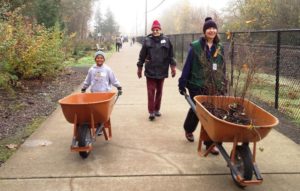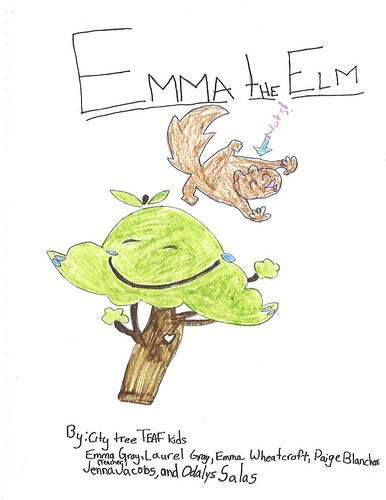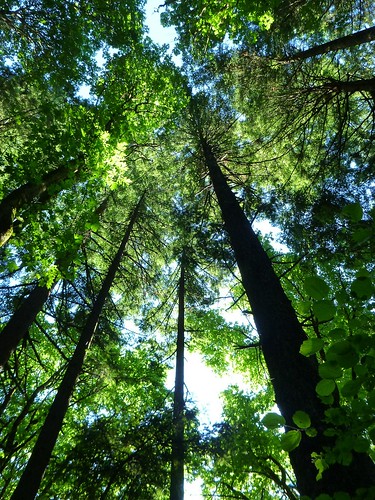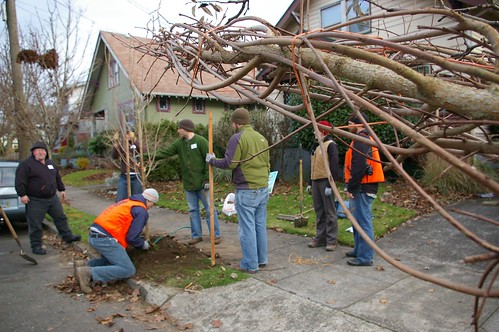Tag: carbon
Learn how trees help make us healthy
 Do you know how increased exposure to nature creates countless health benefits?
Do you know how increased exposure to nature creates countless health benefits?
Join us for a free Trees & Health event–in Portland, Salem and Eugene
Trees benefit people, creatures and the planet in ways too numerous to list here. We know that trees combat climate change, clean our air and water, create habitat, grow food … Trees do so much that it’s no surprise that trees improve our health, too—but it’s only relatively recently that we’ve learned just how much trees contribute to human health. Friends of Trees is now using that knowledge to implement programming specific to trees and health.
Thanks to a 2016 funding award from Metro, Friends of Trees has expanded our community tree-plantings to include Portland’s Northwest Industrial District, focusing on projects to directly impact human health. Our goal is adding green infrastructure to this area that has an abundance of concrete and a dearth of green. These plantings will also forge a stronger connection between the Industrial District and Forest Park, which is so close yet so disconnected from this part of town; adding trees in the industrial section contributes to a green corridor, channeling the benefits of the park to the industrial district.
How do trees make us healthy? Patients in hospitals heal more quickly if they have a view of trees and nature; people are more likely to get out and walk and run through tree-lined communities; babies in tree-lined neighborhoods are more likely to have a healthy birth weight; exposure to greenspaces can reduce blood pressure and stress levels; views of natural settings have been found to reduce crime and aggression … to list just a few.
Yes, the trees we plant here will improve our health, but so will the way we plant those trees. Our community tree-planting program is implemented with thousands of volunteers, many of whom have never volunteered before. And guess what? Volunteering is good for your health, too! Volunteering makes us happy, contributes to more satisfied employees, decreases the risk of depression, reduces stress levels, and more!
And to help these trees grow and thrive, Friends of Trees will water, mulch and prune these new trees for their first two years in the ground. This is slow and steady work, and we are excited to continue growing this program over time.
There’s another component to this project: Scientists. Presentations by experts are a part of our Trees and Health work. It’s an exciting time, with new research coming out regularly, and we look forward to sharing this important information with our community.
Learn more about trees and health.
JOIN US FOR A FREE TREES & HEALTH EVENT
Guest lecturer Dr. Kathy Wolf of the University of Washington explores how nearby nature improves environmental, social, and economic conditions in cities
- Portland, March 1, 6-7:30 p.m.
- Salem, March 2, 6-7:30 p.m.
- Eugene, March 3, 5:30-7:00 p.m.
Location and registration information.
This is an excerpt from our February Treemail, read the entire issue here.
Carbon Sequestration – the Green Dot Project
By Brighton West
The Green Dot Project facilitates a substantiated community consensus building process which increases human capacity to implement, measure, innovative and adopt methods to put carbon in the ground. They provide the local community with education, capacity building, problem-solving, and organizational strategies for planning and carrying out action strategies. The consensus-driven action plans are created by community members, including elders, young individuals, nonprofits, for-profits, and governmental agencies. In the consensus building process, fears are expressed and addressed, transformational beliefs and behaviors are identified and cultivated, a mechanism for action is firmly established, and action plans are developed.Read More
How city trees cool & clean our air

By Neva Knott
“Trees breathe carbon dioxide, a greenhouse gas, most of which comes from vehicles. Other particulate matter is emitted into the air by industry, fires, fuel burning, agriculture, and all kinds of human activity. As trees take up CO2 and other pollutants they filter the air—at the rate of 25 million pounds a year here [in Portland, Oregon]. The larger and healthier the tree, the more filtration. Think of the old neighborhoods full of maples, cherries, and tulip trees, working hard to help us breathe. And interestingly, researchers have discovered that urban trees begin to store carbon at an earlier age that do rural or wilderness trees.
“The economic aspect of air filtration, mainly that of carbon storage, comes in the form of carbon trading. More and more, industries that send the pollutants into the air pay tree growers for the air-cleaning capacity of their trees. Cities are now able to compete in this market. In fact, buyers often pay more for credits that are attached to sustainable projects with local, social benefits, such as urban tree-planting programs. Another program that works with trees to clean the air of carbon is the Municipal Trees Restoration Program. Twenty-five cents of each Oregon vehicle registration fee is allotted to the program. The money is then used to plant trees in highway rights-of-way. In this way, trees are considered part of the transportation system. It takes about 20 trees to offset driving one car for 60 miles each day.
A hot topic: trees in our cities

City trees are a hot topic today, in more ways than one.
“We can cool down temperatures in cities over the period of a decade or two by aggressively planting trees,” said Georgia Tech professor Brian Stone on NPR’s “Talk of the Nation” today. His recently published book is “Around the World, Cities Plan for Extreme Weather.”
In addition, Congressman Earl Blumenauer sent this message to his constituents today:
“This summer has been disastrous for millions of Americans, as unpredictable and severe weather has caused enormous loss of life and property. Climatologists are slow to put 100% of the blame for these events on climate change, but those of us with open eyes and a few decades under our belts can see the changes going on around us:
“Almost twice as many heat records in the US have been broken this year as last year and the past 12 months were the hottest on record. So far this year, wildfires have burned more than 2.2 million acres across the country.
Trees: public or private goods?

Are trees private or public goods?
Who benefits when you plant a tree?
How do you know that the tree you pay to plant in another part of the world is actually planted and nurtured?
Read Tree-conomics in today’s New York Times to learn more. Below is an excerpt from the story:
The difference between private and public benefits explains why some local communities regulate tree management. But more profoundly, it drives a hardwood wedge between individual and social outcomes, with disturbing implications. Deforestation is contributing to global warming.
Why are rational economic actors having such a hard time responding to this problem? Partly because it can’t be reduced to individual choices. It requires coordinated actions that involve collective conflict, coalition-building and strategic maneuver.
You can learn more about the multiple benefits of planting city trees on Friends of Trees’ web site. Please consider planting trees with us this year at your home or in a public green space to benefit you, your family, and the entire community.
–TR
